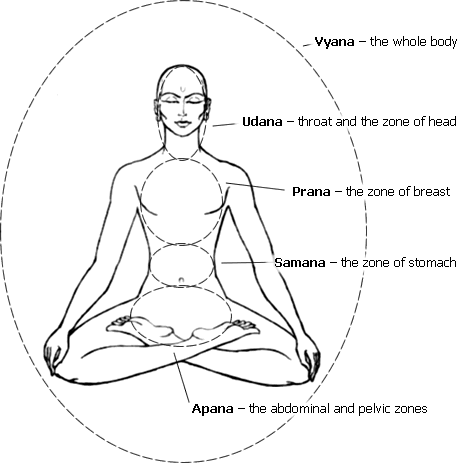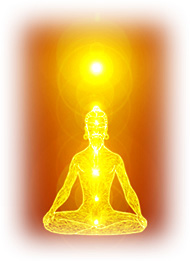Practice Antahkarana Antahkarana Pranas (winds) Pranas (winds)
There are main five pranas in the body:
- Vyana vayu is the omnipresent wind,
- Udana vayu is the ascending wind,
- Prana vayu is the supporting life wind,
- Samana vayu is the wind similar to the fire,
- Apana vayu is the falling (descending) wind.

Vyana-Vayu
(the energy spreaded through the body)
It pierces the whole body. Vyana-Vayu is a protective envelope of a physical body. Vyana-Vayu moves through the whole body. It hasn't any certain localization; it surrounds the body from all sides and forms an aura. Vyana-Vayu bands together different organs and body parts. A sense of skin thanks to nerves, nutrients, energy motions along superficial channels in any part of the body are under the action of Vyana-Vayu. By means of Vyana-Vayu you can influence energy of another man, breathe through pores with the whole body, flesh and bones.
It controls voluntary and involuntary muscle motion of the whole body and joints. It helps to hold the body upright. During the death consciousness and feelings move to Vyana-Vayu.
Vyana-Vayu furthers joining contemplation and practice to any action of the body, work, motions etc. Choice of a new womb, talent for needlework and drawing, creation of an insubstantial body in dreams are action of Vyana-Vayu.
Vyana-Vayu is a pure radiance of the endless consciousness 'Self' — a subject in the highest transcendental state — Samadhi (Turiyatita).
A yogin controls the process of the Vyana-Vayu breathing methods (through skin and bones).
Vyana-Vayu and luminescence of aura
The thin spiritual energy (Ojas) influences fire (Tejas) manifesting itself from the thin body on a physical level. Ojas forms fife basic Vayus, particularly Vyana-Vayu. Vyana-Vayu is responsible for an aura - a luminous radiance. Thanks to this radiant self-energy of a man manifests itself in an outer world. The protective layer Vyana-Vayu surrounding a man guards him against thin-material negative substances.
Form and color of an aura depend on a grade of Vyana-Vayu, a state of the basic Pranas and Consciousness. They manifest themselves as radiance (Kala) of particular color and power.
Udana-Vayu
(Energy that goes up)
Udana-Vayu activates sense organs. Thanks to Udana-Vayu a yogin can hear, see and smell. Udana-Vayu nourishes thinking and memory. Udana-Vayu becomes active during opening of Vishuddha-Chakra and Sahasrara-Chakra; it also opens the central channel. It is Udana that gives thin spiritual experiences.
Siddhi Udana-Vayyu enables to:
~ levitation,
~ walking on thorns, quagmires and water,
~ jump high.
It is experienced in sleep without dreams (Turya). This is manifestation of realization of cavitated wisdom of the Highest Self. You feel motion in your spine as radiance or as internal fever when motion of thoughts goes out and Pure Consciousness without conceptions gets revealed.
Udana-Vayu occupies an area of the throat and the head. It performs a function of falling asleep, separates an astral body from a physical one after the death, controls swallowing and mimicry. When Prana and Apana flow together, Udana goes into Sahasrara focusing Consciousness on the highest worlds.
Prana-Vayu
(Energy of breathing)
It is situated in a breast controlling breathing. It becomes more intensive while you are taking a breath. It is responsible for Prana uptake in the process of breathing. Prana is active day long. Prana has a quality of moving up. The task of a yogin is to direct Prana downward that it can unite with Apana. The function of Prana is absorption of outside energy through breathing. It is experienced in sleep with dreams (Svapna). A yogin has control of Prana by means of the throat lock (Jalandhara-Bandha).
Samana-Vayu
(Fire-like Energy)
This Prana is localized in an umbilical zone and inflames a body heat; it also takes part in gastrointestinal digestion and intestinal uptake. It takes power from food and balances Prana and Apana. It becomes active between inhalation and exhalation. It is experienced as an internal vibration. Its area of action is sleep without dreams (Sushupti), when Prana and Apana dissolve in Samana-Vayu. A quality of Samana is to balance Apana
Clean energy of Samana raises heat, joy and bliss in the body; it burns unclean Pranas in the channels, gives mind lucidity. Unclean energy of fire causes greed for food and goods, irascibility.
Clean Samana-Vayu causes a new kind of joy and bliss in the umbilical region. This is joy of life itself. If the Samana-Vayu function is shot a yogin feels laziness, indolence, dullness. He sleeps a lot and his mind is inert.
A yogi controls Samana-Vayu by means of an abdominal lock (uddiyana-bandha).
Apana-Vayu
(Top-down Energy)
This energy is connected with water. It controls urination, dejection, orgasm, ejaculation, gas outlet, ejection of a fetus in childbirth, erection and sexual attraction. If there is lack of Apana-Vayu these functions are also short. With relation to the Tantra practice Apana-Vayu is important for emotional experience of Bliss-Emptiness that is experienced in Svadhistana-Chacra and Manipura-Chacra.
Location of Apana-Vayu is below a navel: kidney, anus, genitals, large intestine and rectum. Apana becomes intensive during exhalation. Apana is active at night; its quality is to move downward.
The task of a yogin is to lift Apana that it unites with its Prana in a umbilical region. A yogin controls Prana by means of constriction of anus (Ashvini-Mudra), perineum (Mula-Bandhi), a male urethral channel (Vadjroli-Mudra) and vaginal muscles.
Five less Pranas:
- Naga performs functions of vomit, hiccup and bringing round,
- Kurma opens and closes eyelids, recalls the phantoms,
- Krikara causes sneezing, hunger, thirst, cough,
- Devadatta causes sleep, yawning,
- Dhanandjaya is dispersed all over the body and remains in it after the death.
«Naga works during eructation, Kurma during winking, krikara as is known causes unintentional sneezing and Devadatta causes yawning.
Dhananjaya that has filled the whole body doesn't even leave a dead body. These Pranas are vital forces that wander across all Nadis».
Mahasiddha Gorakshanath "Gorakshashatakam" (1.36 - 37)
|
